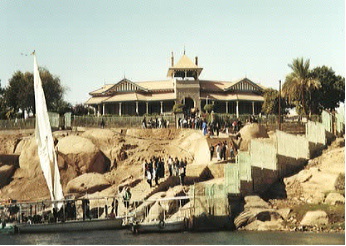|
Elephantine Island has been inhabited for
over 5000 years and its modern owners Kenuzi Nubians are a proud
people with their own unique cultures and traditions.
The Elephantine Museum is located on Elephantine
Island and has artifacts primarily related to that area. The
white clapboard house where the museum is located also has the
distinction of being the former villa of Sr. William Willcocks,
the designer of the first Aswan dam. Some the more notable
exhibitions at the museum include a mummified Ram of Khnum, a
golden bust of Khnum, statues of Amenhotep III with goddesses
and prehistoric schist basins |
|
Elephantine is an island in the centre of the
Nile at Aswan. This was the original 'border town' between Egypt
and the Nubian lands to the south and in ancient times was an
important strategic position both for the defence of the border
and as a trading route. The island has been inhabited from the
Early Dynastic Period through Roman times until the present day.
Its ancient name was 'abu' or 'yebu', which means elephant and
was probably derived from the shape of the smooth grey boulders
which surround the island, looking like elephants in the water.
Elephantine Island is the largest of the Aswan area islands, and
is one of the most ancient sites in Egypt, with artifacts dating
to predynastic periods. This is probably due to its location at
the first Cataract of the Nile, which provided a natural
boundary between Egypt and Nubia. As an island, it was also
easily defensible. In fact, the ancient town located in the
southern part of the island was also a fortress through much of
it's history. At one time, there was a bridge from the mainland
to the island . .
Elephantine is Greek for elephant. In ancient times, the Island,
as well as the southern town, was called Abu, or Yabu, which
also meant elephant. The town has also been referenced as Kom,
after it's principle god of the island, Khnum (Khnemu). It is
believed that the island received it's name because it was a
major ivory trading center, though in fact, it was a major
trading post of many commodities. There are large boulders in
the river near the island which resembled bathing elephants,
particularly from afar, and this too has been suggested as a
reason for the island's name.
One of it's main attractions is it's Nilometer, which is one of
only three on the Nile, which was used to measure the water
level of the Nile as late as the nineteenth century.Another
major attraction is the ruins of the Temple of Khnum.
Elephantine Island was considered to be home of this important
Egyptian god, and while this structure dates back to the Queen
Hatshepsut of the 18th Dynasty, there are references to a Temple
of Khnum on the island as early as the 3rd Dynasty. There are
also ruins of a Temple of Satet, who was Khnum's female
counterpart, also build by Queen Hatshepsut, a shrine to Hekayib
from the 6th Dynasty, a local governor who was deified after his
death. His cult flourished during the middle kingdom, and some
fine statues from the shrine are now in the museum. There are
also mud-brick vaults of the late period which housed the bodies
of the royal rams. On the south end of the island is a small one
room Ptolemaic temple which was constructed from materials
removed from the Kalabsha Temple. Here, there are decorations
attributed to the Nubian Pharaoh Arkamani from the 3rd century
BC The building seems to have been finished by the Romans with
reference to Caesar Augustus.
A First Intermediate Period palace area has been uncovered on
Elephantine, which includes a large bakery, situated near the
south-western harbour gate. This was constructed using high
octagonal wooden columns, eight of these have been preserved and
are among the earliest examples of such columns. The bakery,
which was occupied over several phases, probably between
Dynasties IV to XI, has been found to contain ovens and
thousands of bread moulds. Ostraca containing distribution lists
and mentioning the cult of Heqa-ib have also been found.
On the northern edge of the monumental area, behind the modern
Nubian village, can be seen the remains of a small granite step
pyramid, dated to Dynasty III, but its precise purpose is
unknown. This is one of seven small mud brick Old Kingdom
pyramids which are spread throughout the Nile Valley from Aswan
to Abu Rawash. The north of the Satis Temple there are mud brick
tombs of the sacred rams from the Late Period (the famous ram's
sarcophagus can now be seen in the Nubian Museum) A cult shrine
of Heqa-ib who was a deified governor of Elephantine in the
Middle Kingdom can be seen to the west of the Satis Temple. His
tomb can be seen among the nobles tombs on the West Bank of
Aswan .
The Aswan Museum at the entrance to the island is still open and
has recently been extended. The exhibits remain in their
old-fashioned dusty glass-covered cases, but there are some very
interesting items from Elephantine which date right back to
Predynastic times. The northern end of the island is dominated
by the Oberoi Hotel inside an enclosure and there are three
modern Nubian villages .
|